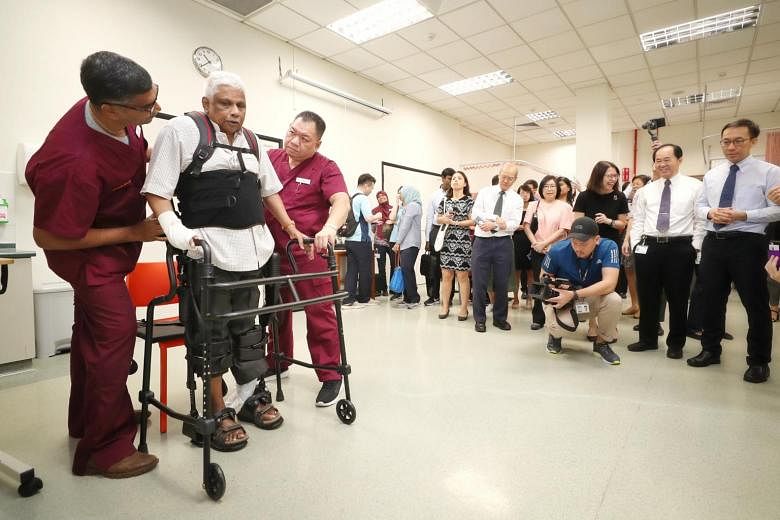SINGAPORE - A spinal cord injury 15 years ago crippled Ms Teresa Tan and left her in a wheelchair, but wearing a bionic exoskeleton has helped her to walk again.
Ms Tan and 35 other patients who are unable to walk independently due to neurological diseases are part of a study looking at the effectiveness of using exoskeletons - external skeletons that support and protect the body - in rehabilitation.
The Temasek Foundation-Improving Mobility via Exoskeletons (iMove) programme will study patient outcomes and assess the viability and potential for scaling-up the use of robotic exoskeletons in rehabilitation care, from the hospital to the community.
It will seek to improve the mobility and independence of patients - especially elderly ones - suffering from conditions like stroke, and spinal cord injuries, said Professor John Wong Eu Li, chief executive of the National University Health System (NUHS).
He was speaking at the launch event held at Alexandra Hospital on Monday (May 6).
Robotic-assisted devices are increasingly helping therapists to provide high-intensity, repetitive and task-specific treatment, which is hard for patients to achieve once they are discharged from hospital, he added.
Stroke is the leading cause of long-term disability and loss of mobility here, with new annual cases having risen from 5,500 to 7,400 over the last decade.
Three exoskeletons will be used at the NUHS' five partner sites - Alexandra Hospital, NTUC Health, St Luke's Eldercare, St Luke's Hospital and Stroke Support Station.
NUHS is the first national health system in Asia to study how advanced exoskeleton technology can improve mobility and rehabilitation outcomes across the care system.
Philantrophic organisation Temasek Foundation and non-profit organisation Trailblazer Foundation will provide a total of $1.34 million in funding over two years to buy the exoskeletons and train 12 physiotherapists to use them.
The exoskeletons are supplied from United States exoskeleton company Ekso Bionics.
The plan is to recruit a total of 400 patients, with at least 80 per cent of them aged 66 and above, said Dr Effie Chew, the chief of Rehabilitation Services at Alexandra Hospital.
Initial results have shown that four of the six patients who completed the programme have improved in at least one category of functional mobility since using the suit, she added.
Of the 400 patients, 100 patients will serve as the control group who do not use the exoskeleton suit.
Patients may be eligible for the study if they are not able to walk independently, and will first be assessed by a physiotherapist and doctor.
Each patient is entitled to 12 sessions of using the exoskeleton.
Ms Tan, who suffers from inflammation of the spinal cord, has gone through 10 sessions and now needs only 30 per cent assistance from the exoskeleton, less than half of the 70 per cent required when she first started.
"I've improved a lot and I feel excited," she said. "I wish I could continue using it."
Mr Yap Thian Yong, a physiotherapist at St Luke's Hospital, said: "The suit allows for more consistent practice of the joint movements because the motors at the hip, knee and ankle can be adjusted according to how much assistance the patient needs from the machine."
But the exoskeleton is not suitable for patients who have a very limited range of joint motion or have poor upper limb strength, he added.
Mr Chan Heng Kee, Permanent Secretary of the Ministry of Health, said that technology can be a "force multiplier" that raises productivity, lightens the physical demands on therapists and lowers manpower needs.
Technology also has the added benefit of making rehabilitation more accessible and fun for patients, improving their compliance, and has the potential to improve diagnosis, monitoring and therapy effectiveness, said Mr Chan, who was the guest of honour at the event.
A national task force to advance the knowledge and use of technology in rehabilitation was also formed on Monday.
The Advance Rehabilitation Technology Special Interest Group, which comes under the Society of Rehabilitation Medicine, brings together rehabilitation professionals such as doctors, therapists, engineers, nurses and care teams.


